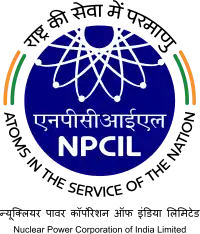Nuclear Power Corporation of India
The Nuclear Power Corporation of India Limited (NPCIL) is an Indian public sector undertaking based in Mumbai, Maharashtra. It is wholly owned by the Government of India and is responsible for the generation of nuclear power for electricity. NPCIL is administered by the Department of Atomic Energy (DAE).
 | |
| Type | Public Sector Undertaking |
|---|---|
| Industry | Electric utility |
| Founded | September 1987[1] |
| Headquarters | World Trade Centre, , India[2] |
Area served | India |
Key people | S. K. Sharma (Chairman & MD) |
| Products | Electric power |
Production output | 46472 MU (2019-20) [3] |
| Services | Electricity generation |
| Revenue | |
| Total assets | |
| Total equity | |
| Owner | Government of India (100%) |
Number of employees | 11,233 (March 2019) |
| Website | www |
NPCIL was created in September 1987 under the Companies Act 1956, "with the objective of undertaking the design, construction, operation and maintenance of the atomic power stations for generation of electricity in pursuance of the schemes and programmes of the Government of India under the provision of the Atomic Energy Act 1962." All nuclear power plants operated by the company are certified for ISO-14001 (Environment Management System).
NPCIL was the sole body responsible for constructing and operating India's commercial nuclear power plants till setting up of BHAVINI Vidyut Nigam) in October 2003. As of 10 August 2012 the company had 21 nuclear reactors in operation at seven locations, a total installed capacity of 6780 MWe.[5][6] Subsequent to the government's decision to allow private companies to provide nuclear power, the company has experienced problems with private enterprises "poaching" its employees.[7]
Nuclear plants
Operational
| Unit | Type | Capacity (MWe) |
Since |
|---|---|---|---|
| TAPS-1 (Tarapur, Maharashtra) | BWR | 160 | 28 October 1969 |
| TAPS-2 (Tarapur, Maharashtra) | BWR | 160 | 28 October 1969 |
| TAPS-3 (Tarapur, Maharashtra) | PHWR | 540 | 18 August 2006 |
| TAPS-4 (Tarapur, Maharashtra) | PHWR | 540 | 15 September 2005 |
| RAPS-1 (Rawatbhata, Rajasthan) | PHWR | 100 | 16 December 1973 |
| RAPS-2 (Rawatbhata, Rajasthan) | PHWR | 200 | 1 April 1981 |
| RAPS-3 (Rawatbhata, Rajasthan) | PHWR | 220 | 1 June 2000 |
| RAPS-4 (Rawatbhata, Rajasthan) | PHWR | 220 | 23 December 2000 |
| RAPS-5 (Rawatbhata, Rajasthan) | PHWR | 220 | 4 February 2010 |
| RAPS-6 (Rawatbhata, Rajasthan) | PHWR | 220 | 31 March 2010 |
| MAPS-1 (Kalpakkam, Tamil Nadu) | PHWR | 220 | 27 January 1984 |
| MAPS-2 (Kalpakkam, Tamil Nadu) | PHWR | 220 | 21 March 1986 |
| NAPS-1 (Narora, Uttar Pradesh) | PHWR | 220 | 1 January 1991 |
| NAPS-2 (Narora, Uttar Pradesh) | PHWR | 220 | 1 July 1992 |
| KAPS-1 (Kakrapar, Gujarat) | PHWR | 220 | 6 May 1993 |
| KAPS-2 (Kakrapar, Gujarat) | PHWR | 220 | 1 September 1995 |
| KGS-1 (Kaiga, Karnataka) | PHWR | 220 | 6 November 2000 |
| KGS-2 (Kaiga, Karnataka) | PHWR | 220 | 6 May 2000 |
| KGS-3 (Kaiga, Karnataka) | PHWR | 220 | 6 May 2007 |
| KGS-4 (Kaiga, Karnataka) | PHWR | 220 | 27 November 2010 |
| KKNPP-1 (Kudankulam, Tamil Nadu) | VVER | 1000 | 22 October 2013 |
| KNPP-2 (Kudankulam, Tamil Nadu) | VVER | 1000 | July-2016 |
| Total Capacity | 6780 |
Under construction
| Unit Under Construction | Type | Capacity (MWe) |
Expected Date |
|---|---|---|---|
| KAPS-3 (Kakrapar, Gujarat) | PHWR | 700 | 2020( achieved criticality)[8] |
| KAPS-4 (Kakrapar, Gujarat) | PHWR | 700 | 2019[8] |
| RAPS-7 (Rawatbhata, Rajasthan) | PHWR | 700 | 2018[8] |
| RAPS-8 (Rawatbhata, Rajasthan) | PHWR | 700 | 2019[8] |
| KKNPP-3 | VVER | 1000 | [9] |
| KKNPP-4 | VVER | 1000 | [9] |
| Total Capacity | 4800 |
Proposed
| Power Plant | Type | Capacity (MWe) |
|---|---|---|
| Jaitapur in Maharashtra | EPR | 9900 (6 × 1650 MW) |
| Gorakhpur in Haryana [10] | PHWR | 2800 (4 × 700 MW) |
| Mithi Virdi in Gujarat | LWR | 6000 (6 × 1000 MW) |
| Kovvada in Andhra Pradesh | ESBWR | 6000 (6 × 1000 MW) |
| Chutka in Madhya Pradesh | PHWR | 1400 (2 × 700 MW) |
| Bhimpur, Shivpuri in Madhya Pradesh | PHWR | 2800 (4 × 700 MW) |
| Total Capacity | 28900 |
See also
References
- "About Us". NPCIL. Retrieved 28 March 2019.
- "Contact Us". NPCIL. Retrieved 28 March 2019.
- https://www.npcil.nic.in/WriteReadData/userfiles/file/MA_News_12may2020_01.pdf
- "Balance Sheet 31.03.2020".
- "Plants in Operation". www.npcil.nic.in. Archived from the original on 17 December 2010. Retrieved 10 July 2010.
- "Kaiga-4 achieves criticality". The Hindu. Chennai, India. 28 November 2010.
- Private sector giants `poach' NPCIL personnel The Hindu, Monday, 20 November 2006
- "Kaiga's 700 MWe units to be delayed; first one may become critical in 2024". Deccan Herald.
- http://www.world-nuclear-news.org/Articles/Construction-officially-begins-on-Kudankulam-3-and
- https://www.deccanherald.com/content/666424/excavation-work-nuclear-power-plant.html